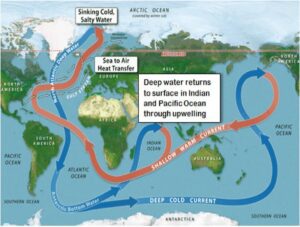THE GLOBAL OCEAN CONVEYOR BELT
Global ocean
conveyor belt is a constantly moving system of water driven by temperature and
salinity in the deep ocean and the wind-driven currents on the surface. It
starts in the Norwegian Sea (North
Atlantic) where cold saline water sinks to the bottom of the ocean and moves
south of the equator all the way down
to Antarctica, and finally upwells in the Indian and the Pacific oceans to
complete the cycle as shallow warm surface currents.
Global ocean conveyor belt consists of:
-
Deep waterformation:The evaporative cooling and ice formation in North Atlantic make the water more
saline and dense. The surface water, thus sinks to the ocean bottom. Warm
surface water from the Gulf Stream moves in to replace the sinking water.
-
Spreading of deep water
:The high latitude cooling and the low latitude heating makes the deep watermove southwards as North Atlantic Deep Water current. After reaching
Antarctica, the current gets recharged because of strong cooling and sinking of
water in the region and forms the Antarctic Circumpolar current. This current
splits into two, one move towards Indian Ocean, while the other towards
Pacific.
·
Upwelling of deep water:
These aforementioned two sections warm up and become
less dense as they travel northward toward the equator, and return to
the surface through mixing and wind-driven upwelling.
·
Near-surface
currents: Outflowing of cold undersea waters in the Pacific makes the sea level of the Atlantic slightly lower. This
gives rise to the near surface currents. The warm, fresher water hence loops
back to the South Atlantic, eventually returning to the North Atlantic, where
the cycle begins again.
Significance for marine ecosystems:
- ·
Maintaining Ocean salt budget:
The oceanic
circulation helps in balancing the salinity of ocean
water across the world.
·
Maintaining Ocean
heat budget: It
helps in the distribution of heat from the tropics to the poles and from the
depth of the water to the surface.
·
Influences polar
ice formation: Global
conveyor belt supplies heat to the Polar Regions. Therefore, influences the
rate of sea ice formation near poles, which in turn affects the climate system,
albedo and solar heating.
·
Sink for carbon
dioxide: Before sinking, the water absorbs
enormous amounts of gases such as carbon dioxide at the sea surface, and then transports them
rapidly to much greater depths. This
dissolved carbon dioxide remains buried to the ocean depths for centuries.
·
Facilitates
Nutrient circulation: Warm surface waters are depleted of nutrients and
carbon dioxide, but they are enriched again as they travel through the conveyor
belt as deep or bottom layers. The base of the world’s
food chain depends on the cool, nutrient-rich waters that support the growth of algae and seaweed.
· Oxygen enrichment: The mixing of warm
and cold currents helps to replenish oxygen and favour growth of plankton, the
primary food for fish population.
·
Long distance
migration in the marine environment: Ocean gyres and currents help marine
animals such as sea turtles to migrate across oceans for spawning and
reproduction.
There is a concern
that the Global Ocean conveyor belt is getting affected due to global warming. The increased melting of polar ice
might disturb this delicate temperature-salinity based circulation which is essential for the marine ecosystem
and climate of earth.

